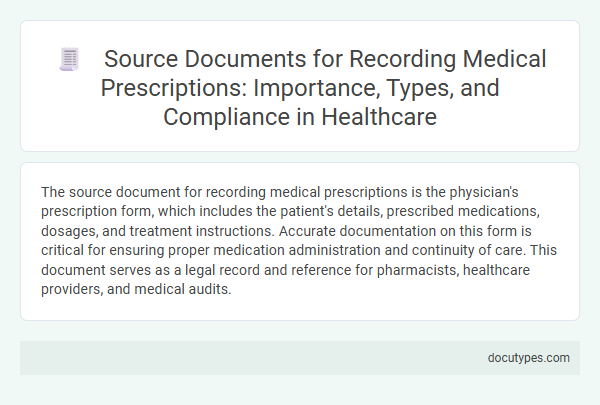The source document for recording medical prescriptions is the physician's prescription form, which includes the patient's details, prescribed medications, dosages, and treatment instructions. Accurate documentation on this form is critical for ensuring proper medication administration and continuity of care. This document serves as a legal record and reference for pharmacists, healthcare providers, and medical audits.
Introduction to Medical Prescription Source Documents
Medical prescriptions serve as essential source documents in healthcare, providing accurate records of prescribed medications. These documents ensure clear communication between healthcare providers and pharmacies for safe patient treatment.
- Definition of Source Document - A source document is the original record capturing detailed information about a patient's prescribed medication.
- Importance in Medical Records - Source documents like prescriptions validate treatment decisions and support clinical audits and patient safety.
- Types of Prescription Documents - Paper forms, electronic prescriptions, and handwritten notes are common formats serving as primary sources for medical prescriptions.
Importance of Accurate Prescription Record-Keeping
| Topic | Details |
|---|---|
| Source Document for Medical Prescriptions | The primary source document for recording medical prescriptions is the original prescription issued by a licensed healthcare provider. This document contains critical information such as drug name, dosage, frequency, and duration of treatment, serving as the authoritative reference for pharmacists and medical professionals. |
| Importance of Accurate Prescription Record-Keeping | Accurate prescription record-keeping ensures patient safety by minimizing medication errors and enabling effective treatment monitoring. Maintaining precise records supports legal compliance, facilitates clear communication among healthcare providers, and assists in audits or investigations. Your adherence to detailed documentation safeguards patient health and enhances the quality of care. |
Types of Source Documents in Prescription Recording
The source document for recording medical prescriptions is the original record that captures the details of prescribed medications. It serves as the primary reference for pharmacists, healthcare providers, and regulatory compliance.
Types of source documents in prescription recording include handwritten prescriptions, electronic prescriptions (e-prescriptions), and verbal orders that are promptly documented. Each type ensures accurate medication administration, patient safety, and legal accountability in medical practice.
Electronic vs. Paper-Based Prescription Documentation
The source document for recording medical prescriptions serves as the primary record of a patient's prescribed medications. Understanding the differences between electronic and paper-based prescription documentation is crucial for accuracy and compliance in healthcare settings.
Electronic prescriptions use digital platforms to create and store prescriptions, enhancing accessibility and reducing errors. Paper-based prescriptions rely on handwritten or printed records that are manually filed and maintained.
- Electronic Prescription Documentation - Offers real-time access to prescription data and integration with electronic health records (EHR).
- Paper-Based Prescription Documentation - Provides a tangible record but is susceptible to misplacement and transcription errors.
- Impact on Healthcare Providers - You benefit from improved prescription accuracy and streamlined workflows with electronic systems compared to traditional paper methods.
Legal and Regulatory Requirements for Prescription Records
The source document for recording medical prescriptions is the original prescription issued by a licensed healthcare provider. Legal and regulatory requirements mandate that these records be accurate, complete, and securely maintained to ensure patient safety and compliance with healthcare laws. Your medical facility must retain prescription records for a specified period, as dictated by local and national regulations, to support audits and legal inspections.
Ensuring Data Integrity in Medical Prescriptions
The source document for recording medical prescriptions is the original prescription written by a licensed healthcare provider. This document serves as the primary reference to ensure accuracy and completeness in patient medication records.
Ensuring data integrity in medical prescriptions involves verifying the authenticity and clarity of the source document. Accurate transcription of the prescription into electronic health records prevents errors and safeguards patient safety. You must always cross-check dosage, drug names, and patient information against the original prescription to maintain data accuracy.
Role of Source Documents in Medication Safety
The source document for recording medical prescriptions is the original prescription form or electronic prescription record generated by the healthcare provider. These documents serve as the primary reference for pharmacists, nurses, and other healthcare professionals to ensure accurate medication dispensing and administration. Your reliance on precise source documents plays a critical role in maintaining medication safety and preventing errors.
Challenges in Managing Prescription Source Documents
What is the source document for recording medical prescriptions? The primary source document for medical prescriptions is the original prescription written or electronically generated by the healthcare provider. Managing these source documents can be challenging due to issues like legibility, storage, and ensuring accuracy during the transcription process. You must maintain strict protocols to prevent errors and unauthorized alterations that could affect patient safety.
Best Practices for Compliance in Prescription Documentation
The source document for recording medical prescriptions is the original prescription form or electronic prescription generated by the healthcare provider. This document serves as the primary reference for dispensing medications and maintaining accurate patient records.
Best practices for compliance in prescription documentation include ensuring legibility, accuracy, and completeness of patient information and prescribed medication details. Maintaining secure storage and prompt updating of prescription records supports regulatory adherence and patient safety.
What Is the Source Document for Recording Medical Prescriptions? Infographic

